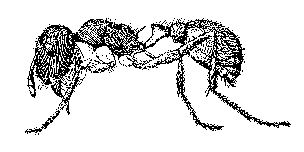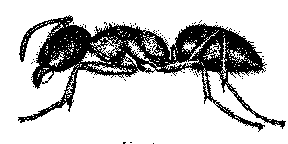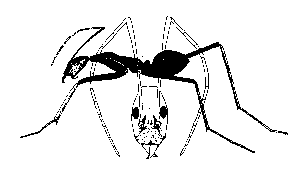
If you watch an ant for a while, chances are that it will appear to be aimless. Interpreting an ant's behavior is so difficult that often it's easier to conclude that the ant is doing whatever the observer thinks it ought to be doing. If the ant is on the kitchen counter, it must be looking for food. If the ant is near an ant of another species, it must be displaying its brawn. You have to watch more than one ant to learn anything about their behavior, because of every five ants that embark on a task, three will never manage to do it before you get distracted or lose sight of them. The other two might turn out to be doing something you never thought of.
Ant colonies perform many different tasks. A few tasks are common to almost all species of ants. Ants leave the nest, find food, and bring it back. They build the nest and repair it. They feed and groom the larvae, and they move the pupae around. Ants do an astonishing variety of other things as well.

The fungus-growing ant Atta texana and the fire ant Solenopsis invicta make elaborate underground tunnels to take foragers to their destinations. Joan and Gary Fellers found that several species of Aphaenogaster use pieces of leaves to soak up the juices of crushed dead insects, and carry the food back to the nest, or to cover a newly discovered food source, thus hiding it from other scavengers while they go back to the nest to recruit nestmates to help retrieve it.
We know of many amazing things that ants do, and still anyone who watches ants is in for surprises. Trails of leafcutter ants, collecting leaves to feed their fungus gardens, look like a fleet of tiny sailboats, the ants carrying pointed bits of cut leaves high above their heads. But the first time I saw a leaf-cutter ant in the wild, it was dragging a caterpillar back to the nest. They aren't supposed to eat caterpillars.
Brian Fisher told me that once he was walking in the rain forest in the Peruvian Amazon, felt that he was being observed, and realized that it was an Eciton ant, perched on a branch and watching him go by. Most ants can't see, and visual tracking isn't generally part of the ant repertoire.

Simon Robson reports that the Australian ant Polyrachis sokholoa swims: the ant walks up to a puddle and then plunges right in, swimming neatly across in a kind of dog-paddle.
We've all heard about the marvelous efficiency of ants. Last summer, I spent a few hours in a forest in Mexico following a trail of another Cephalotes species, C. goniodontur, as they made their way from one tree to another. The ants went slowly up vines, down twigs leaning casually against other plants, and around tiny branches. The trail of ants never touched the ground and went a total of thirty-eight meters to get from one tree to another three meters away. There may be a good reason, perhaps to avoid predators on the ground or other ants on the trunks of the trees, but I haven't figured out what it is.
Sometimes an ant does something completely out of character for its species. Phil Ward described to me a surprising burst of courage from an ant of Pseudomyrmex apache. These ants live on plants, mostly manzanita, in northern California. They usually vanish at the first sign of another ant species, retreating or darting around to the other side of the branch. Ward was astonished to see a Pseudomyrmex worker confront another ant, the winter ant Prenolepis imparis. Instead of running away, the Pseudomyrmex worker burst out of its hole, clamped its mandibles around the Prenolepis ant, who was probably even more surprised than Ward was, and killed it on the spot. We will never know whether her nestmates gave her a purple heart or recommended therapy.
The best generalization we can make about ant behavior is that we don't know much about it, and ants continue to surprise us.

Interaction, Networks and Colony Behavior
Deborah M. Gordon
©2010, Princeton University Press